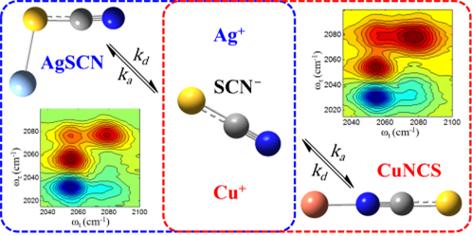Cation-specific ion pairing dynamics between M+ (M=Ag or Cu) and SCN−in N,N-dimethylthioformamide (DMTF) are studied by vibrationally probing the nitrile (CN) stretching vibration. SCN− ion, which is an ambidentate ligand, readily associates with cations to form two different types of contact ion pair (CIP) (i.e., M-SCN or M-NCS) and its CN stretching frequency is significantly blue-shifted so that free SCN− and CIPs can be spectrally well-distinguished in FTIR spectra. Interestingly, Ag+ ion prefers forming Ag-SCN in DMTF (Ag+ + SCN− → Ag-SCN) but Cu+ ion forms Cu-NCS (Cu+ + SCN− → Cu-NCS). We have studied the effect of ion-ligand binding on the ion pairing equilibria and dynamics in great detail by using FTIR, IR pump-probe, and two-dimensional infrared (2DIR) spectroscopy combined with quantum chemical calculations. First, our quantum chemical calculations corroborate that Ag-SCN and Cu-NCS of the two possible CIP configurations (M-SCN or M-NCS) are energetically stable and favored in DMTF. Second, the thermodynamics properties (ΔH and ΔS) of ion pairing equilibria are determined by temperature-dependent FTIR experiments. Finally, IR PP and 2DIR experiments are used to measure the association and dissociation rate constants. Ion pairing dynamics between Cu+ and SCN− are found to occur on much faster timescales than those between Ag+ and SCN−. Our current results provide important insights into understanding the effect of ion-ligand binding on the ion pairing equilibria and dynamics in polar solvents.

http://pubs.rsc.org/en/content/articlelanding/2017/cp/c6cp08852j#!divAbstract
 Aziridine-Functionalized Polydimethylsiloxanes for Tailorable...
Aziridine-Functionalized Polydimethylsiloxanes for Tailorable...
 Ultrafast fluxional exchange dynamics in electrolyte solvatio...
Ultrafast fluxional exchange dynamics in electrolyte solvatio...

















